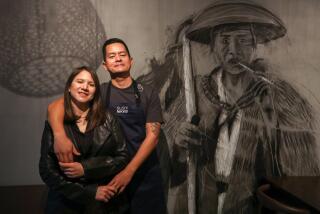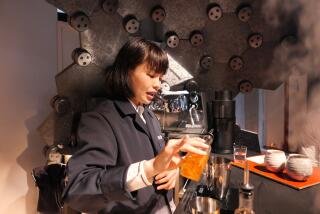TRAVEL INSIDER : How to Survive a Trip to Land of Rising Yen : Japan: Although the country is more expensive than ever, various lodging, dining and transportation options can make it more affordable for Westerners.
- Share via
For months now, the yen has been rising, the dollar falling. And anyone planning a trip to Japan--especially a first-timer--should be paying close attention.
Japan was already known as one of the planet’s most expensive places: As of Jan. 1, the U.S. State Department was allowing government employees up to $200 per night for lodging in Tokyo and $92 per day for meals and other expenses. And much of the historic run-up of the yen’s value against the dollar has come since then.
Back on Nov. 29, 1992, $1 bought 117.4 yen through Thomas Cook Foreign Exchange. As of June 23, the company was selling yen at 105.4 to the dollar. The figure was even more extreme before the trend cooled earlier last month, but even so, the Nov. 29-June 23 fluctuation amounts to a decline of roughly 10% in the dollar’s buying power.
This trend is potentially good news for those worried about this country’s trade deficit with the Japanese; a weaker dollar effectively raises the price of Japanese goods here and cuts the price of American goods in Japan. But neither Japanese tourism officials nor American travelers will be much consoled by that.
Last month, the travel consultant firm Runzheimer International found that a whole chicken cost $4.28 per pound (four times more than in Los Angeles); a 6.5-ounce can of tuna cost $2.40 (almost three times as much as in Los Angeles); a two-liter soft drink cost $5.73 (more than four times as much as in Los Angeles), and a liter of vodka cost $24.27 (more than twice as much as in Los Angeles). A 24-exposure roll of color film, on the other hand, cost $4.33--three cents less than in Los Angeles.
Japanese tourism officials say it’s too soon to tell how much effect the exchange rate slide will have on American travel business, or to tell when rates will stabilize, but anxieties are rising. After running flat at 2.1 million tourist arrivals in each of 1991 and 1992, Japan could face a downturn in visitors.
“We’re still receiving the same number of phone calls,” says Maria Heffner, spokeswoman for the Japan National Tourist Organization in New York. “I don’t think people are backing out of trips if they’ve already made plans. What people are doing is asking more questions about affordable restaurants and affordable transportation and other things.”
The tourist office’s response: Heffner and her colleagues are pushing the 2-year-old, but often-overlooked Welcome Inn Reservation Center program. Callers to the agency’s Los Angeles or New York offices (telephone 213-623- 1952 or 212-757-5640) can request a Welcome Inn directory of 421 lodgings in Japan with rates under 8,000 yen (roughly $80) per night. Most of the listings are in Tokyo and Kyoto, but less populous areas are included as well.
With at least two weeks of advance time before departure, reservations can be made via mail through an address listed on the Welcome Inn brochure. Welcome Inn reservations centers are also located in Tokyo and Kyoto, and in Narita Airport, about an hour outside Tokyo.
Many of the least expensive lodgings in the country are traditionally Japanese in design, which means Westerners need to adjust to a new series of words: Ryokan are Japanese-style inns with tatami mats and futons rather than beds. Minshuku are family-run inns that more closely resemble Western bed and breakfast operations. Kokumin shukusha are more rustic lodgings in national parks, run either privately or by the government. Americans should also note that a Japanese “business hotel” does not necessarily charge the high-end rates found at American hotels that cater to corporate clientele. (Those hotels are often in business districts, but tend to be Spartan and strictly functional.)
Beyond that, much of the usual advice to budget-minded tourists anywhere applies: Don’t take taxis or eat in hotels if you can avoid it; don’t automatically turn up your nose at food sold by sidewalk vendors, and study guidebooks to learn the lay of the land.
Like all Lonely Planet publications, the new “Tokyo City Guide” ($8.95) pays particular attention to the interests of the low-budget traveler. (It also reminds readers just how wildly U.S.-Japan economic relations have fluctuated over the years: Before World War II, the yen traded four to $1; four years after Japan’s defeat in 1945, the rate was 360 yen to $1.)
Other money-saving strategies will be less obvious to new hands in Japan. For instance, there is no tipping--not in restaurants, not in hotels, not in taxis.
Maria Heffner of the tourism office points out that most large department stores in Japan have restaurants. The prices are usually reasonable--a substantial meal for $15 or less. As is common in Japan, these arrangements usually include plastic window displays to help non-speakers of Japanese choose their dishes.
Heffner also notes that many non-hotel coffee shops, which are common throughout Japanese urban areas, offer quasi-American breakfast specials. For $5 and under, she says, travelers can often find a meal of coffee, toast and eggs.
Travelers should keep an eye out, too, for businesses with promotions aimed specifically at the exchange-rate gap. The upscale Akasaka Prince Hotel in Tokyo (tel. 800-542-8686, 800-637-7200 or 800-448-8355) early this month started pitching a “Yen Buster” promotion, aimed primarily at luring American business travelers wary of the exchange rate.
“Our room rates have not increased significantly over the past several years,” said Hideo Matsumoto, the hotel director of guest relations, in announcing the promotion. “However, we realize that the weakened dollar has made travel to Japan very expensive for U.S. business people.”
The Yen Buster Executive package, available through December, includes a standard single room measuring approximately 250 square feet (about the size of a California suburban bedroom, which is larger than many Japanese business hotel rooms); in-room fax machine; breakfast; pressing of one item of clothing upon arrival, and one lunch or dinner per day. The cost: 31,000 yen, including tax and service charges. That is, about $300. (But if you can do without the fax machine, the hotel will knock another 2,000 yen off the daily bill.)
American operators of tours to Japan, too, have been forced into some changes by the exchange rate slip.
San Francisco-based InnerAsia Expeditions (tel. 800-777-8183), which expects to send a combined total of about 75 travelers on tours to Japan this fall, built its budget plans around a presumed exchange rate of 125 yen per $1. With the dollar so much weaker than that, the company is invoking a clause in its passenger agreements that allows for surcharges to cover large currency fluctuations. As a result, travelers on 16-day tours this fall are being asked to add an average of $250 to previously announced package prices of $3,125 to $3,285, air fare excluded.
At San Diego-based Japan & Orient Tours (tel. 619-282-3131), tour organizers have added $230 to the price of their 12-day trip to Japan this September, bumping the price for the upscale package from $3,890 to $4,120, air fare included.
Brent Olson, Japan director for InnerAsia, acknowledges that exchange rates are “something we’re keeping a close eye on.” But, he adds, “Price has always been a factor with Japan, a hurdle to get over. If you’re thinking about traveling to Japan, you need to deal with that psychologically before you go.”
Olson also counsels that Western travelers can save some money, and enhance their cultural experience, by following a strategy InnerAsia tries to stress at all times: Look for Japanese-style meals and transportation--local cuisine rather than steak, for instance, and trains rather than bus tours.
(Instead of buying individual rail tickets, travelers may be better off buying Japan Rail Passes, available in one-week, two-week and three-week increments, which allow nationwide travel on Japan Railways lines with some restrictions. A one-week pass runs about $260.)
At Japan & Orient Tours, director of Orient product development Joanne Lutz notes that “Japan has not been selling that well in the last couple of years, anyway.” She attributes that not only to the dollar’s gradual erosion, but also rising curiosity about relatively inexpensive China and Southeast Asia.
“The fact that China and Southeast Asia are so attractive right now in terms of prices (is important),” says Lutz. “It’s really significant for China this year. People are going a little bit farther for less money.”
More to Read
Sign up for The Wild
We’ll help you find the best places to hike, bike and run, as well as the perfect silent spots for meditation and yoga.
You may occasionally receive promotional content from the Los Angeles Times.







